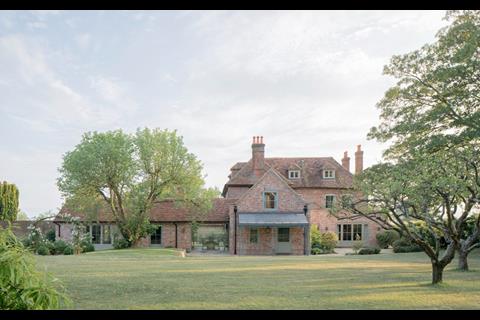Muyiwa Oki described the six shortlisted projects as “truly remarkable, breathtaking pieces of architecture”
RIBA has announced the shortlist for the 2024 House of the Year award, which recognises the UK’s best new home.
Contenders for the annual prize are drawn from the wider cohort of 2024 RIBA Award winners covering England and Wales.
Surman Weston, Town Dowdall Architects, Hugh Strange Architects, Taylor Hare Architects, Studio Brassica Architects and 31/44 Architects are all in the running for this year’s gong.
RIBA said the list represented a broad mix of different design approaches that are located across deeply rural and densely urban areas.
It includes upgraded listed buildings such as The Hall by Taylor Hare, a refurbished grade II-listed 16th century house in Kent, and Plas Hendy Stable Block by Studio Brassica, a grade II-listed Arts and Crafts stable block in Monmouthshire which has been restored as a family home.
It also includes four “beautifully crafted” new homes, two in London on complex city sites and two in rural settings.
RIBA president Muyiwa Oki said the six homes “show how we can deliver high-quality residential architecture with impact”.
“Individually, they are truly remarkable, breathtaking pieces of architecture; together they offer scalable solutions to issues faced by our built environment – from reinventing existing buildings to working with complex and constrained sites,” he said.
“However, their true success lies in the health and wellbeing of those that live inside them: there can be no greater mark of achievement for an architect.”
The award’s jury chair Je Ahn said the list “shows the breadth of possibilities” for what a house could be.
“From rural contexts to tight urban sites, including fine craftsmanship and intergenerational living amongst other driving forces – all these houses are essentially about the people who live inside.
“Together the shortlisted exemplars offer scalable solutions to the urgent issues of today – displaying care towards sustainability and social changes, including the revival of historic buildings which don’t negatively impact the natural environment.”
What RIBA said about the six shortlisted homes
Farmworker’s House, Cornwall, by Hugh Strange Architects
Nestled into a wooded field, this deceptively simple home adopts an introverted courtyard house typology, its L-shaped plan sheltering a south-facing garden. Thick masonry walls of monolithic clay blocks form the protective wings, simply finished with textured lime render. Beyond the walls, the surrounding agricultural land is left untouched, allowing livestock to graze right up to the boundary walls. Inside, smooth unpainted lime plaster mirrors the roughcast outside, while dark brick floors throughout recall Victorian stable pavers, and an exposed roof structure of locally-grown Douglas Fir hangs above.
Peckham House, London, by Surman Weston
This small but generously-spaced family home is full of enthusiasm and playfulness, with a façade defined by a distinctive pattern of hit-and-miss brickwork that playfully interprets the local houses. It sits on the end of an unassuming urban terrace, which makes the most of a small site, including a roof terrace to provide some needed outside space.
Eavesdrop, Sussex, by Tom Dowdall Architects
Designed for retirement, the home is focused on wellbeing, calm and flexibility, with level thresholds for full accessibility, as well as light, tranquil spaces that open up to host friends and family. A generous central courtyard provides sunlight, fresh air, and year-round enjoyment of plants and wildlife. With its sweeping, rising roof, simple construction, and stone finishes, the house fits seamlessly into the landscape, while close up, the beauty of its stone detailing is revealed.
The Hall, Kent, by TaylorHare Architects
Situated in the Kent Downs, this Grade II listed 16th century residence has been extensively and sympathetically refurbished into a sustainable home. Interiors have been both restored and modernised, with finely crafted detailing and considered new interventions that work in harmony so that the historical compliments the contemporary. The house is an exemplar of green living, while simultaneously restoring the surrounding listed outbuildings and adding a pool, pool house, tennis court, stable block, and a new lake. The end result is a demonstration of how to extend the life of a historic building, while creating elegant living spaces for the future.
Plas Hendy Stable Block, Monmouthshire, by Studio Brassica Architects
A Grade II listed Arts & Crafts stable block has been rescued and restored to create a novel and accessible family home. Simple materials, detailing, and variation are applied in spirited and thoughtful ways, balancing aesthetic, heritage, and ecological obligations, while upgrades to sustainability and references to the Arts & Craft movement – such as sawtooth brickwork and quarry tiles – create moments of playfulness while demonstrating the many benefits of repurposing existing buildings.
Six Columns, London, by 31/44 Architects
Designed to meet a family’s changing needs, Six Columns is a flexible, future-facing home intended to evolve with its occupants. It makes efficient and sophisticated use of space, and materials, with sustainable and cost-reducing features. Brutalist references and creative flourishes – a stepping brickwork wall, rustications and pilasters, and a green marble panel – make for a distinct and refreshing aesthetic. Wherever possible, self-finished materials are employed; the ground floor has exposed painted brickwork, and readily-available spruce panels are used to create many of the fittings and joinery, which can be adjusted with ease over time.






















1 Readers' comment